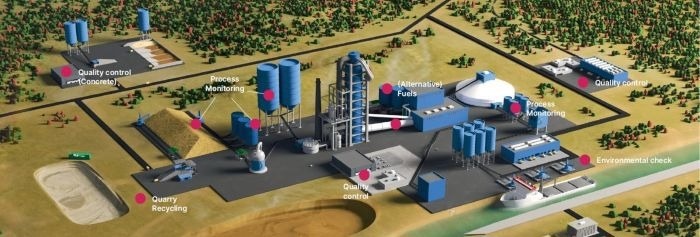Cement manufacturers are under pressure to deliver a more efficient method for cement production, and there is a simple solution: Industry 4.0 technology.

Image Credit: Malvern Panalytical
Industry 4.0 focuses on integrating smart machinery for maximum automation and efficiency, such as the Internet of Things (IoT), artificial intelligence (AI), machine learning, and cloud computing.
By combining your cement analysis tools with Industry 4.0 technology, you can feed real-time insights back into your processes, increasing productivity and reducing downtime.
So, where should manufacturers start when it comes to bringing their operations up to speed with Industry 4.0? The answer lies in getting the right data by correctly calibrating your instruments.
Synthetic CRMs Set the Starting Line for XRF Optimization
X-ray fluorescence (XRF) is a widely adopted technique in cement plants, valued for its ability to deliver fast, non-destructive chemical analysis throughout the production process. It supports high-quality manufacturing by serving four key application areas: raw material analysis, process control, quality control, and environmental compliance.
To achieve the accuracy and reproducibility XRF is known for—and that modern, data-driven Industry 4.0 systems rely on—precise calibration is essential. Your measurements are the foundation for digital optimization, and any errors at this stage can lead to significant downstream inaccuracies.
It all begins with proper sample preparation. This typically involves crushing the material into a fine powder, then pressing it into pellets. This approach is popular for routine production monitoring due to its balance of simplicity and reliability.
For greater precision and reproducibility, the sample can be fused with a flux—usually a borate—to create a homogeneous glass bead. This fusion method minimizes matrix effects and particle size interference, leading to more accurate results.
Certified reference materials (CRMs) play a critical role in this process. These standards ensure measurement traceability, validate your analyses and support instrument calibration.
Synthetic CRMs, such as Malvern Panalytical’s WROXI standards, are produced under ISO 17034 accreditation, ensuring consistent quality and traceability. As synthetic materials, WROXI standards are reliably available, helping avoid supply issues common with natural reference materials.
The kit includes pre-mixed powders and clear preparation instructions, streamlining the calibration process. It supports both primary calibration with fused glass disks and secondary calibration with pressed powders, offering flexibility across analytical workflows.
For more specialized needs, Malvern Panalytical’s experts can also develop custom CRMs tailored to specific process requirements.
With reliable calibration standards in place, cement producers can confidently integrate XRF analytics across operations—laying the groundwork for smarter, more efficient production systems.
Fully Automated Materials Analysis with Industry 4.0 Technology
By leveraging Industry 4.0 technologies to feed insights from analytical instruments directly back into your process streams, cement plants can accelerate issue response and even prevent problems before they occur. This approach not only reduces equipment downtime but also enhances overall productivity.
Automation can be integrated at various stages of production—for example, by combining the Zetium XRF system with the Aeris Cement XRD instrument to create a fully automated laboratory.
The Aeris Cement instrument can be connected to a belt or robotic system for fast, automated sample processing. It’s primarily used to identify and quantify crystalline phases in raw materials, clinker, and finished cement—critical for maintaining cement quality and performance. It also supports the monitoring of clinker phases and the study of hydration products during R&D.
When paired with elemental data from the Zetium XRF system via automated data transfer, teams gain access to a comprehensive view of material composition. To streamline this further, Malvern Panalytical offers the Twin solution, which links Aeris and Zetium Cement instruments through a shared Supervisor software platform. This setup delivers seamless, in-depth analytical insights.
To support ongoing optimization, Malvern Panalytical’s Smart Manager software acts as a cloud-based control room, connecting and monitoring instruments in real time. It offers a clear view of instrument utilization and health, backed by proactive support from specialists who flag potential issues and guide corrective actions.
Incorporating Industry 4.0 solutions like these into cement production processes can drive significant performance improvements across the plant.
Acknowledgments
Produced from materials originally authored by Murielle Goubard of Malvern Panalytical.

This information has been sourced, reviewed and adapted from materials provided by Malvern Panalytical.
For more information on this source, please visit Malvern Panalytical.